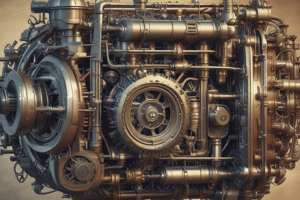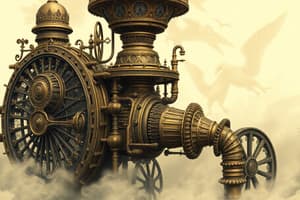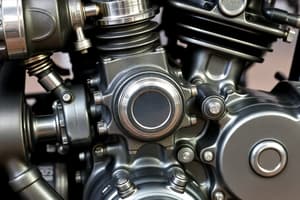Podcast
Questions and Answers
What is the main difference in the heat addition process between the Otto cycle and the Diesel cycle?
What is the main difference in the heat addition process between the Otto cycle and the Diesel cycle?
- Both cycles add heat at constant volume.
- Both cycles add heat at varying pressures.
- Otto cycle adds heat at constant volume, while Diesel adds at constant pressure. (correct)
- Otto cycle adds heat at constant pressure, while Diesel adds at constant volume.
Which statement correctly describes the compression ratio in Diesel engines compared to Otto engines?
Which statement correctly describes the compression ratio in Diesel engines compared to Otto engines?
- Diesel engines have an undefined compression ratio.
- The compression ratio is the same for both types of engines.
- Diesel engines have a higher compression ratio than Otto engines. (correct)
- Diesel engines have a lower compression ratio than Otto engines.
What is the efficiency formula for the Diesel cycle?
What is the efficiency formula for the Diesel cycle?
- η = 1 - (1/r^(γ-1))
- η = 1 - (1/r^(γ-1)) * ( (γ * (r^γ - 1))/(γ - 1) ) (correct)
- η = 1 - (γ/r)
- η = (γ - 1)/γ
Which of the following assumptions is NOT made for the Diesel cycle?
Which of the following assumptions is NOT made for the Diesel cycle?
Which fuel type is specifically used in Otto cycle engines?
Which fuel type is specifically used in Otto cycle engines?
Flashcards are hidden until you start studying
Study Notes
Air Standard Cycle
- Definition: The air standard cycle is an idealized thermodynamic cycle that simplifies the analysis of internal combustion engines by assuming that the working fluid is air and that the cycle follows specific processes.
Otto Cycle
-
Description:
- Used in gasoline engines.
- Operates on the principles of constant volume heat addition and isentropic (adiabatic) processes.
-
Processes:
- Process 1-2: Isentropic compression (air is compressed adiabatically).
- Process 2-3: Constant volume heat addition (fuel is ignited, raising the temperature).
- Process 3-4: Isentropic expansion (hot gas expands doing work on the piston).
- Process 4-1: Constant volume heat rejection (exhaust is expelled, lowering temperature).
-
Key Parameters:
- Compression Ratio (r): Ratio of the cylinder volume at bottom dead center (VBDC) to the volume at top dead center (VTDC).
- Efficiency (η): Defined as η = 1 - (1/r^(γ-1)), where γ (gamma) is the specific heat ratio (Cp/Cv).
-
Ideal Assumptions:
- No friction losses.
- Perfect gas behavior.
- Constant specific heats.
Diesel Cycle
-
Description:
- Used in diesel engines.
- Operates on principles of constant pressure heat addition and isentropic (adiabatic) processes.
-
Processes:
- Process 1-2: Isentropic compression (air is compressed adiabatically).
- Process 2-3: Constant pressure heat addition (fuel is injected and ignited while the piston moves).
- Process 3-4: Isentropic expansion (the gas expands, performing work).
- Process 4-1: Constant volume heat rejection (exhaust gases are expelled).
-
Key Parameters:
- Compression Ratio (r): Typically higher than in Otto Cycle, usually between 14 and 25.
- Efficiency (η): Defined as η = 1 - (1/r^(γ-1)) * ( (γ * (r^γ - 1))/(γ - 1) ). Diesel engines typically have higher efficiency compared to Otto engines.
-
Ideal Assumptions:
- No heat loss to surroundings.
- Constant specific heats.
- Perfect gas behavior.
Comparison of Otto and Diesel Cycles
- Fuel Type: Otto uses gasoline, Diesel uses diesel fuel.
- Compression Ratio: Diesel has a higher compression ratio.
- Efficiency: Diesel cycle generally has higher thermal efficiency.
- Heat Addition: Otto cycle adds heat at constant volume, while Diesel adds heat at constant pressure.
Air Standard Cycle
- An idealized thermodynamic model for analyzing internal combustion engines using air as the working fluid.
Otto Cycle
- Specifically designed for gasoline engines.
- Fundamental operations include constant volume heat addition and isentropic processes.
- Processes Involved:
- Process 1-2: Isentropic compression increases pressure and temperature through adiabatic compression.
- Process 2-3: Constant volume heat addition occurs as fuel ignites, raising the gas temperature.
- Process 3-4: Isentropic expansion allows hot gases to do work on the piston.
- Process 4-1: Constant volume heat rejection expels exhaust, reducing the temperature.
- Key Parameters:
- Compression Ratio (r): Measures cylinder volume at bottom (VBDC) vs. top dead center (VTDC).
- Efficiency (η): Calculated as η = 1 - (1/r^(γ-1)), where γ represents the specific heat ratio (Cp/Cv).
- Ideal Assumptions:
- Ignored friction losses ensure an ideal scenario.
- Assumes perfect gas behavior and constant specific heats throughout the cycle.
Diesel Cycle
- Engine cycle tailored for diesel engines.
- Operates primarily on constant pressure heat addition and isentropic processes.
- Processes Involved:
- Process 1-2: Adiabatic compression of air increases pressure without heat transfer.
- Process 2-3: Constant pressure heat addition from fuel injection and ignition during piston movement.
- Process 3-4: Isentropic expansion of gases generates work on the piston.
- Process 4-1: Constant volume heat rejection occurs when exhaust gases are expelled.
- Key Parameters:
- Compression Ratio (r): Generally ranges from 14 to 25, exceeding that of the Otto cycle.
- Efficiency (η): Determined by the formula η = 1 - (1/r^(γ-1)) * ( (γ * (r^γ - 1))/(γ - 1) ), contributing to higher overall efficiency than Otto engines.
- Ideal Assumptions:
- Assumes no heat loss to the atmosphere.
- Consistent specific heats and perfect gas behavior are maintained.
Comparison of Otto and Diesel Cycles
- Fuel Type: Otto cycles utilize gasoline, while diesel cycles rely on diesel fuel.
- Compression Ratio: Diesel cycles feature a significantly higher compression ratio than Otto cycles.
- Efficiency: Diesel engines typically achieve greater thermal efficiency compared to Otto engines.
- Heat Addition Process: Otto cycles involve heat addition at constant volume, contrasting with the constant pressure heat addition of diesel cycles.
Studying That Suits You
Use AI to generate personalized quizzes and flashcards to suit your learning preferences.





